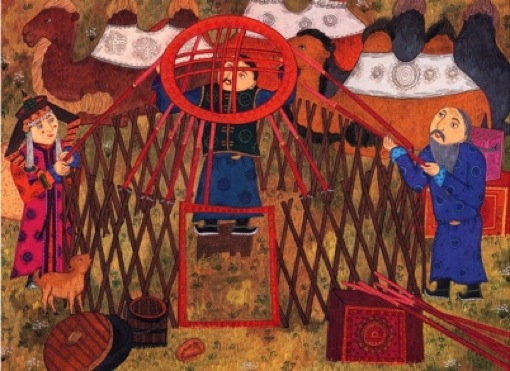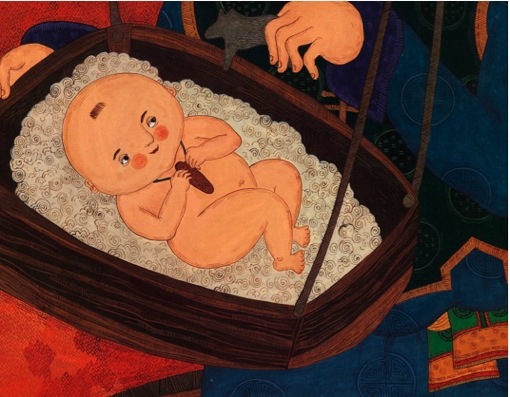Cheri Anderson, University of Arizona, Tucson, Arizona
 The final book we will share is My Little Round House written and illustrated by Bolormaa Baasansuren with an English adaption by Helen Mixter, published by Groundwood Books, 2009. Boloramaa Baasansuren graduated from the Institute of Fine Arts in Mongolia and also studied children’s book illustration in Italy and Russia. She has won numerous awards including Distinguished Best Book of Mongolia and prizes at the International Competition of Illustration (Teario/UNICEF) for her illustrations in Tales on Horseback, the Grand Prize at the international book competition of the National Cultural Festival in Fukuoka, Japan for The Legend of Wives’ Hair, and The Grand Prize at the Noma Concours for the Japanese edition of My Little Round House. She lives in Ulaanbaatar, Mongolia. Boloramaa Baasansuren’s extensive firsthand knowledge of Mongolian culture radiates throughout her extraordinary illustrations.
The final book we will share is My Little Round House written and illustrated by Bolormaa Baasansuren with an English adaption by Helen Mixter, published by Groundwood Books, 2009. Boloramaa Baasansuren graduated from the Institute of Fine Arts in Mongolia and also studied children’s book illustration in Italy and Russia. She has won numerous awards including Distinguished Best Book of Mongolia and prizes at the International Competition of Illustration (Teario/UNICEF) for her illustrations in Tales on Horseback, the Grand Prize at the international book competition of the National Cultural Festival in Fukuoka, Japan for The Legend of Wives’ Hair, and The Grand Prize at the Noma Concours for the Japanese edition of My Little Round House. She lives in Ulaanbaatar, Mongolia. Boloramaa Baasansuren’s extensive firsthand knowledge of Mongolian culture radiates throughout her extraordinary illustrations.
The little round house is a “ger,” a Mongolian moveable house used by Nomadic people as they move from camp to camp with the changing of the seasons. Jilu, the baby narrator, tells of his first year of life from birth to the following summer. The story includes the rich details of traditional Mongolian life. Jilu begins his narration inside an orange sphere floating on the first page that invites us as readers to make an immediate emotional connection with this baby narrator. On the next page we are introduced to the naked baby shivering from the cold alone against a white background. Children will notice he is shivering through the the use of motion lines surrounding the baby. As the reader turns the page, the rich influx of color and pattern emerges in the illustration. This color and pattern symbolically introduce the sense of family and love so prevalent in the unfolding story.
The circle has been a profound visual symbol throughout art history as a symbol of completeness, unending love, all encompassing, and cyclical by its very form. It has been used as a classic symbol for family. The structure of the round house, with its round shape and circular opening at the top, reflects all these meanings. In addition, this circle motif is repeated again and again throughout each illustration. The light peach tone of the baby’s head against the dark jewel tones of the rest of the images makes the circle-shaped head seem to float across the illustrations. These circles are found in the subtle pattern in the fabrics of each family member’s garments, and the patterns in the rugs. The batting in the bed’s texture and the rolls in the table are spiraling circles, and the stars in the sky are tiny concentric circles. Over and over throughout the illustrations children will discover these hidden patterns of circles.
Oblique distortion of perspective enhances the “mural” feel of the illustrations. Color is used symbolically as referenced by the blue coloring of one of the lambs. The rich tapestry-like illustrations illuminate interiors of the ger. These illustrations are predominately warm jewel tones: reds, oranges, and golds. The warm colors help to emphasize the cozy feeling of the inside of the tent. In contrast the exterior scenes are more reflective of a cool color palette with the introduction of more greens and blues. Both exterior and interior illustrations show the rich luxurious detail of the clothing and artifacts within the ger despite the arduous process of repeated packing and moving.
The images also reflect animals that are well cared for, delectable dishes for the family to eat, and musical instruments to enjoy together. These images together represent prosperity and contentment within the culture that baby Jilu has been born into. As the circle is a symbol of closure, this book closes with the end of the first year of baby Jili’s life. The reader senses it is only the beginning of many years enveloped in the rich Mongolian culture.
The illustrations in beautifully executed picture books enrich our lives, increase our understandings and offer joy to readers. One does not have to be an art expert in order to engage with the images in books. Children instinctively search and wonder their way through these images. Their orientation to the unknown world around them has made them visual experts as they naturally engage with the images that surround them. Children breathe in these images like oxygen, essential to how they learn and think. As reviewers, we need to regain our sense of the significance of visual images to meaning-making and bring those understandings into how we discuss picture books with other readers.
Cheri Anderson, University of Arizona, Tucson, AZ.
Journey through Worlds of Words during our open reading hours: Monday-Friday, 9 a.m. to 5 p.m. and Saturday, 9 a.m. to 1 p.m.
- Themes: Bolormaa Baasansuren, Cheri Anderson, My Little Round House
- Descriptors: Books & Resources, Debates & Trends, WOW Currents



This is quite an interesting book. Yes, it’s short and simple, for the young reader, but by its very nature it teaches how different life can be for different peoples. I liked this book and reading to my little reader, and she liked it as well!
Thankyou,
Jason